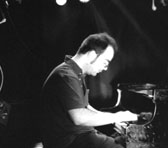22 October 2009
MIAF: Seven Last Words of Jesus Christ on the Cross
Melbourne // VIC // 14.10.2009
 Image: Anthony Pateras, one of the 6 composers commissioned for this project
Image: Anthony Pateras, one of the 6 composers commissioned for this project © Philo Lenglet
Tonight's concert formed the centrepiece of a triptych of music presentations inspired by the Crucifixion, performed at St. Patrick's Cathedral in Melbourne as part of the 2009 Melbourne International Arts Festival. The main focus was Joseph Haydn's 1801 quartet cycle of the same title, commissioned by the canon of Cádiz. These seven long adagios, augmented by an introduction and a vigorous finale, were originally composed to frame the bishop's discourses as part of the Lenten service. On this occasion, six Australian composers offered short responses to take the place of the sermons.
To contemporary ears, Haydn's adagios certainly need leavening. Working within such limited confines, there is inevitably a sameness of mood and intensity about most of these pieces. This program was carefully designed to throw the string quartets into relief by using contrasting instrumental forces in the interludes. There was also subtle manipulation of the performance space using strategic lighting and different stage positions for the various ensembles.
The main point of interest in such a program was the effect the modern interpolations had on our hearing of the Haydn. Most of the interludes were very brief, serving as cleansers to prepare the ears for the next instalment of the main feature. This hopping between centuries and cultures was intriguing, though sometimes jarring. The first interpolation was a didjeridu work by William Barton, which immediately dragged us out of the late eighteenth century and reminded us just whose land we had built this church on. Barton coaxed bewildering sounds from his instrument, at one point somehow managing to make them seem to be coming from different locations in the cathedral.
A lot of thoughtful planning obviously went into this program, exemplified by some neat symmetries. Andrew Ford's …in Paradiso for three flutes (with multiple layers of digital delay) began in the rich lower registers, and climbed slowly towards a high point, which spliced seamlessly into the first notes of the third quartet. At the other end of the program, James Ledger took the last notes of the sixth quartet as a high starting point for his Descent for contrabassoon, contrabass clarinet and heckelphone, which then slowly traced a circuitous route downwards to the nether regions of these instruments.
Wind sonorities were prominent, and all of the composers showed an awareness of the cavernous acoustic they were working in. Most pieces moved slowly, were polyphonic in nature and contained spaces in which sounds were allowed to resonate throughout the cathedral. I was often reminded of organ wind registrations, especially in Anthony Pateras's more energetic THIRST for oboe, bassoon and cor anglais.
Haydn was composing from a point of religious certainty. His adagios glow with the serenity of pure faith and humility, and most of this evening's composers reflected this in their respect for the main work. Brett Dean's Miniature (Etude for two French horns), on the other hand, was short and bubbly, not even pretending to the sincerity and profundity of the adagios, preferring to offer distraction rather than reinforcement.
The only piece to really challenge Haydn's ethos was Georges Lentz's Ingwe (night) for electric guitar, an extract of a much longer solo guitar work. This piece was certainly effective, but jarred in this context - the loud distorted rock licks seemed to be derived from 1970s guitar hero self-indulgence. The piece was also by far the longest of the new commissions, and did strange things to my reception of the following quartet.
The various ensembles from the National Academy of Music (ANAM) acquitted themselves well, and most benefited from the forgiving acoustic. Though the first couple of adagios were taken soporifically slow, ensemble and balance was fine. The performance of the final adagio in particular displayed beautiful blending and poise. A full string orchestra was employed in the concluding presto, which if not quite successful in portraying the Earthquake of the Apocalypse by modern standards, proved to be a satisfying conclusion to the concert.
Event Details
Melbourne International Arts Festival
Seven Last Words of Jesus Christ on the Cross
Australian National Academy of Music
Music by Haydn, with responses by William Barton, Andrew Ford,
Brett Dean, Anthony Pateras, Georges Lentz, and James Ledger
Creative direction by Matthew Hoy, Ben Cobham, Frog and
Bluebottle
Wednesday 14 October 2009, 9pm
St. Patrick's Cathedral,
East Melbourne, VIC
Further Links
Andrew Ford - AMC
Brett Dean - AMC
Anthony Pateras - AMC
Georges Lentz - AMC
James Ledger - AMC
William Barton artist
website
Melbourne International Arts Festival
event profile
Australian National Academy of Music website
© Australian Music Centre (2009) — Permission must be obtained from the AMC if you wish to reproduce this article either online or in print.
Subjects discussed by this article:
Mark Viggiani is a Melbourne-based composer. His recent works include pieces for the Melbourne and Tasmanian Symphony Orchestras, The Song Company and Speak Percussion. In 1997 Move Records released The Rainmaker, a CD of original compositions, to international critical acclaim. In 2009 Viggiani was awarded an Australian Postgraduate Award towards a PhD in composition, following studies with Stuart Greenbaum and Elliott Gyger at Melbourne University.
Comments
Be the first to share add your thoughts and opinions in response to this article.
You must login to post a comment.